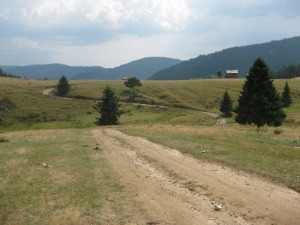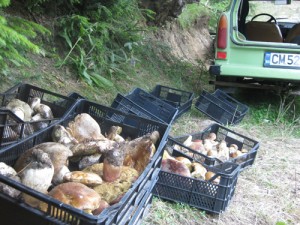Uphill All the Way in the Rhodope Mountains
I have my dinner—cheese, a four-pound organic tomato, a sack of figs and a jar of pickled chanterelles—and I’m ready to get lost on the mountain roads
/https://tf-cmsv2-smithsonianmag-media.s3.amazonaws.com/filer/20110921020010bulgaria-bicycle-hut-thumb.jpg)
Leaving the Rhodope Mountains three days ago, I gravitated back toward Plovdiv, Bulgaria, where I had a shower and a night in a bed. At dawn the sun strikes the clock tower on Sahat Tepe, and the city wakes up. It will soon be sweltering. If I were a local man I’d just roll my T-shirt up to my ribs and belly up to the curb beneath a tree, watching the traffic and drinking espresso. Me, I flee.
I aim for the coast, but the valley is fiery hot, unremittingly flat, and as listless as the stray dogs in the dust. I crave the peace and coolness of the high country cut south to a break in the mountains. I meander up the river canyon, and the hills become peaks. They float past as I go, the landscape unfolding like a story. I go past Assen’s Fortress, Bachkovo Monastery, and a large trout farm on the river. At Hvoyna, I turn up a feeder canyon toward the village of Orehovo. I have my dinner—cheese, an absurd four-pound organic tomato, a sack of figs and a jar of pickled chanterelles—and I’m ready to get lost on the mountain roads. I follow an arrow sign to one Kabata Hut. The road goes sharply uphill and almost immediately turns to dirt, then to grass and mud. I must push my bike on 20-percent grades, uphill through the trees and over fresh-cut logs and boulders. My shoulders ache from the labor. Distances in these mountains are not so great and I trust I can reach the Kabata Hut before dark. The signs continue, meant for hikers, and as dusk comes I begin to imagine that I’ll find a hunting lodge full of French mountaineers cooking venison stew on a wood fire and drinking liters of red wine. They will slap me on the back when I arrive and fill me a bowl and a glass.

A long and winding dirt road in the Rhodope wilderness.
Finally, I see light through the trees as the grade levels. I’ve climbed nearly a vertical mile, and I must be there—and yes: On a level meadow of raspberry thickets I find a cluster of barns. Dogs begin to howl. I see a parked truck. The main hut is, indeed, a sort of tourist chalet, with guns and enameled shelf fungi mounted on the plank wall inside. Just one man is there, a scruffy mountain fellow named Giorgio. He’s wearing boots, a huge sweater and an Elmer Fudd hunting hat, watching Baywatch on TV. I ask if I can camp. He shakes his head and smiles: Yes. And do you serve wine here, I ask? He shakes his head firmly and produces a jug of red wine he made himself. After three glasses I unroll my sleeping bag outside in the trees.
At daybreak, I have an espresso with Giorgio and continue onward. I come over the pass and descend several kilometers to the famed Wonderful Bridges, where cameras do no justice to the towering cliffs and the 100-foot-high tunnels through the rock. Continuing downhill, I’m bound for the main highway again—but I turn up another side road for the sake of exploring. I have my directions straight, and I know the main road is to my left, east, and that I want to keep moving south and that eventually an intersecting stream valley will lead me down to the region’s big town, Chepelare—but it’s farther than I expect. I push my bike uphill for miles, through the mud puddles of the prior day’s thunderstorms, and clouds are building again. The road goes in unexpected directions, and I have soon regained thousands of feet of elevation. In the thick mossy woods, weary-faced mushroom hunters tote sacks of porcini.

Crates of Rhodope porcini by the road, bound for the wholesale market and, eventually, Italy.
A voluminous man drinking beer under a tree in a clearing points back the way I’ve come when I ask, “Chepelare?” No way am I turning back, so I point ahead and ask, “Where?” He shakes his head. Is that a yes? I continue anyway, past a cozy little chapel overlooking a canyon—and then downward into the void. If this road dead-ends, I’m done. I have no energy to climb back. It’s now past 4:00. Rain is falling, and I haven’t eaten since last night. Hunger claws at my stomach. I fight with the shrubbery for a few raspberries, but it’s not worth the effort; I’m reminded of a grizzly that expends 1000 calories digging out a 250-calorie ground squirrel. I bounce down the bumpy, rocky road—and abruptly it turns to brand new, black-topped asphalt. I whoop with excitement and I fly at 30 miles per hour straight into Chepelare. It’s pouring rain now. I eat a melon under a tree in the square, buy cheese, wine and olives and get a hotel room for 10 leva—7 bucks. Sleep comes easily.
It’s not every morning that a man says over coffee, “Today, I think I’ll go to Greece.” But I’m just 48 miles from the border crossing at Zlatograd, and tonight, with any luck, I will be gazing over the Aegean.
Planning Your Next Trip?
Explore great travel deals
Smithsonian magazine participates in affiliate link advertising programs. If you purchase an item through these links, we receive a commission.
/https://tf-cmsv2-smithsonianmag-media.s3.amazonaws.com/accounts/headshot/Off-Road-alastair-bland-240.jpg)
/https://tf-cmsv2-smithsonianmag-media.s3.amazonaws.com/accounts/headshot/Off-Road-alastair-bland-240.jpg)